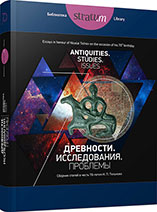Систематизация костно-роговой индустрии раннего железного века Поднестровья (на основе коллекции поселения Чобручи)
A Systematic Outline of Bone and Antler Industry in the Dniester Region Iron Age: some principles from Chobruchi settlement site
Author(s): Valentin B. Pankowski, Sergey A. Fidelski
Subject(s): History, Archaeology, Ancient World
Published by: Издательский дом Stratum, Университет «Высшая антропологическая школа»
Keywords: Dniester Region; Chobruchi; Iron Age; bone and antler industry; classification; traceology
Summary/Abstract: The paper aims to survey current systematizing developments for the osseous industries dated back to the 6th—2nd centuries BC in the Northwest Pontic area. These trends, however, appear to be applicable to any of the many worked-bone-containing parts in the whole archaeological oecumene. The readers are introduced to the classificatory concepts which only have been explicated in parts elsewhere. Basically, the North Pontic archaeologists definitely used to seek their worked bone archaeological record to be completely imposed into classification. Yet any kind of such classifications normally contains impermeable inherent limits set up by the researchers themselves, who usually face a scarcity of comprehensive expert data. Here, some special solutions to the problem are put forward based on systemic classificatory approach. The approach refers to the osseous raw material structures and the ways they have been transformed during manufacture. The technoclasses concept of adapting, modifying, and converting bone and antler during utilization goes back, in particular, to Andrei Borodovskiy’s technological systematics. The traceological studies, in turn, tend to embed all identifiable objects into a system, since many more different means of functional analysis would work as verifying methods. At the same time, the artefacts’ technical functions and the manners they were used are the issues of special research concern. Further, the ways past equipment including instruments, implements, and accessories might have affected on or interacted with objects and substances, resulted in rational shapes and use-wear patterns in artefacts. The entities of tools, devices, joints, furniture, andparaphernalia seem to be quite perceptive to the variability in worked bone and antler record. This kind of arrangement may have been flexibly changed in terms of its units and even sections hierarchy, whereas its principal ideas are here to stay with no need them to be rearranged.
Book: Древности. Исследования. Проблемы
- Page Range: 147-163
- Page Count: 17
- Publication Year: 2018
- Language: Russian
- Content File-PDF

